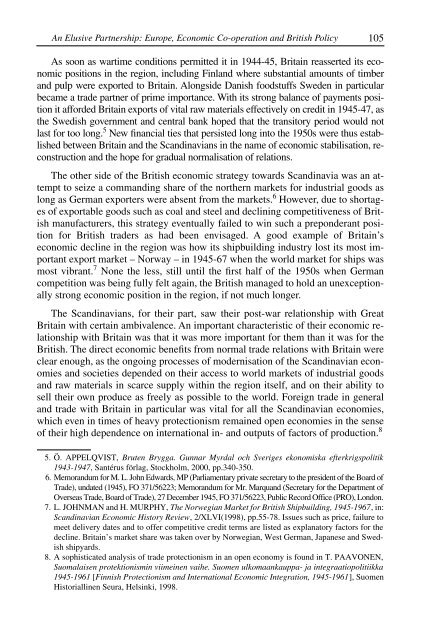journal of european integration history revue d'histoire de l ...
journal of european integration history revue d'histoire de l ...
journal of european integration history revue d'histoire de l ...
Create successful ePaper yourself
Turn your PDF publications into a flip-book with our unique Google optimized e-Paper software.
An Elusive Partnership: Europe, Economic Co-operation and British Policy 105<br />
As soon as wartime conditions permitted it in 1944-45, Britain reasserted its economic<br />
positions in the region, including Finland where substantial amounts <strong>of</strong> timber<br />
and pulp were exported to Britain. Alongsi<strong>de</strong> Danish foodstuffs Swe<strong>de</strong>n in particular<br />
became a tra<strong>de</strong> partner <strong>of</strong> prime importance. With its strong balance <strong>of</strong> payments position<br />
it affor<strong>de</strong>d Britain exports <strong>of</strong> vital raw materials effectively on credit in 1945-47, as<br />
the Swedish government and central bank hoped that the transitory period would not<br />
last for too long. 5 New financial ties that persisted long into the 1950s were thus established<br />
between Britain and the Scandinavians in the name <strong>of</strong> economic stabilisation, reconstruction<br />
and the hope for gradual normalisation <strong>of</strong> relations.<br />
The other si<strong>de</strong> <strong>of</strong> the British economic strategy towards Scandinavia was an attempt<br />
to seize a commanding share <strong>of</strong> the northern markets for industrial goods as<br />
long as German exporters were absent from the markets. 6 However, due to shortages<br />
<strong>of</strong> exportable goods such as coal and steel and <strong>de</strong>clining competitiveness <strong>of</strong> British<br />
manufacturers, this strategy eventually failed to win such a prepon<strong>de</strong>rant position<br />
for British tra<strong>de</strong>rs as had been envisaged. A good example <strong>of</strong> Britain’s<br />
economic <strong>de</strong>cline in the region was how its shipbuilding industry lost its most important<br />
export market – Norway – in 1945-67 when the world market for ships was<br />
most vibrant. 7 None the less, still until the first half <strong>of</strong> the 1950s when German<br />
competition was being fully felt again, the British managed to hold an unexceptionally<br />
strong economic position in the region, if not much longer.<br />
The Scandinavians, for their part, saw their post-war relationship with Great<br />
Britain with certain ambivalence. An important characteristic <strong>of</strong> their economic relationship<br />
with Britain was that it was more important for them than it was for the<br />
British. The direct economic benefits from normal tra<strong>de</strong> relations with Britain were<br />
clear enough, as the ongoing processes <strong>of</strong> mo<strong>de</strong>rnisation <strong>of</strong> the Scandinavian economies<br />
and societies <strong>de</strong>pen<strong>de</strong>d on their access to world markets <strong>of</strong> industrial goods<br />
and raw materials in scarce supply within the region itself, and on their ability to<br />
sell their own produce as freely as possible to the world. Foreign tra<strong>de</strong> in general<br />
and tra<strong>de</strong> with Britain in particular was vital for all the Scandinavian economies,<br />
which even in times <strong>of</strong> heavy protectionism remained open economies in the sense<br />
<strong>of</strong> their high <strong>de</strong>pen<strong>de</strong>nce on international in- and outputs <strong>of</strong> factors <strong>of</strong> production. 8<br />
5. Ö. APPELQVIST, Bruten Brygga. Gunnar Myrdal och Sveriges ekonomiska efterkrigspolitik<br />
1943-1947, Santérus förlag, Stockholm, 2000, pp.340-350.<br />
6. Memorandum for M. L. John Edwards, MP (Parliamentary private secretary to the presi<strong>de</strong>nt <strong>of</strong> the Board <strong>of</strong><br />
Tra<strong>de</strong>), undated (1945), FO 371/56223; Memorandum for Mr. Marquand (Secretary for the Department <strong>of</strong><br />
Overseas Tra<strong>de</strong>, Board <strong>of</strong> Tra<strong>de</strong>), 27 December 1945, FO 371/56223, Public Record Office (PRO), London.<br />
7. L. JOHNMAN and H. MURPHY, The Norwegian Market for British Shipbuilding, 1945-1967, in:<br />
Scandinavian Economic History Review, 2/XLVI(1998), pp.55-78. Issues such as price, failure to<br />
meet <strong>de</strong>livery dates and to <strong>of</strong>fer competitive credit terms are listed as explanatory factors for the<br />
<strong>de</strong>cline. Britain’s market share was taken over by Norwegian, West German, Japanese and Swedish<br />
shipyards.<br />
8. A sophisticated analysis <strong>of</strong> tra<strong>de</strong> protectionism in an open economy is found in T. PAAVONEN,<br />
Suomalaisen protektionismin viimeinen vaihe. Suomen ulkomaankauppa- ja integraatiopolitiikka<br />
1945-1961 [Finnish Protectionism and International Economic Integration, 1945-1961], Suomen<br />
Historiallinen Seura, Helsinki, 1998.
















